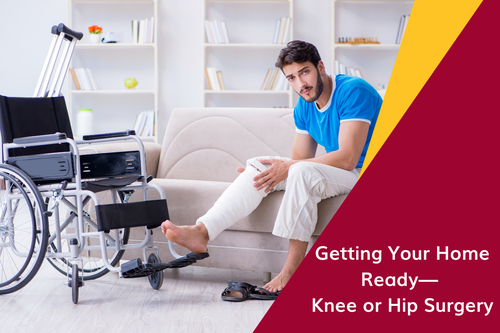At Access Rehabilitation Equipment, we commit to providing you and your loved ones solutions for life! Fitting your lifestyle, each aid and equipment is tailored to the unique challenges you are facing, so work with us to find the independence and mobility you want!

Undergoing knee or hip surgery is a significant step towards improving your mobility and quality of life. However, the recovery process can be challenging, and preparing your home to accommodate your needs post-surgery is crucial for a smooth and comfortable healing journey. In this article, we will guide you through the steps to optimise your living space, focusing on your bedroom, kitchen, and bathroom. We'll also provide tips on handy tools that can assist you during your recovery.
Preparing your home for hip surgery
Before you go to the hospital for surgery, set up your home to make your recovery and life easier when you come back. Ask your doctor, nurse, or physical therapist about getting your home ready.
- When you first leave the hospital, you will need the help of others to perform basic activities like bathing, dressing and managing household chores like cooking and cleaning.
- Arrange for a family member or friend to be available to stay with you for the first week or two.
- If you do not have someone to help you at home for the first 1 or 2 weeks after surgery, discuss with your health care provider about the options of going to a specialised rehabilitation facility after discharge from the hospital or perhaps about having a trained caregiver come to your home to help you. Your hospital should have a list of these facilities.
- Make sure everything you need is easy to get to and on the same floor where you will spend most of your time. If you will need to use the stairs, you should limit using them to once a day.
- Set up a comfortable area in your living room or bedroom where you can rest during the day. Ensure it has good lighting, is near a phone, and has everything you might need within arm's reach.
- Pets that are small or move around may cause you to trip. For the first few weeks you are home, consider having your pet stay elsewhere (with a friend, in a kennel, or in the yard).
- Make sure you can get to your phone. A portable phone can be helpful.
- Place a chair with a firm back in the kitchen, bedroom, bathroom, and other rooms you will use. This way, you can sit when you do your daily tasks.
- If you will be using a wheeled walker, attach a sturdy bag or a small basket to it to hold your phone, a notepad, a pen, and other other things you will need to have close by.
To avoid falls:
- Keep tripping hazards out of your home.
- DO NOT carry anything when you are walking around. You may need your hands to help you balance.
- Remove loose wires or cords from areas you walk through to get from one room to another.
- Remove loose throw rugs.
- Fix any uneven flooring in doorways. Use good lighting.
- Have night lights placed in hallways and rooms that can be dark.
Optimising your bedroom after surgery
Your bedroom should be a comfortable and safe haven for your recovery. Here are some tips to optimise this space:
- Have a bed that is low enough so that your feet touch the floor when you sit on the edge of the bed.
- Set up your bed on the first floor if you can to avoid using stairs. You may not need a hospital bed, but your mattress should be firm.
- Opt for supportive pillows for ergonomic sleeping positions.
- Keep water, medications, a phone, and reading materials on your bedside table.
- Use a bed tray or over bed table for meals and ensure easy access to lighting.
- Place a sturdy chair or bench with armrests next to your bed.
Optimising your kitchen
Preparing meals can be a challenge during recovery, but with a few adjustments, your kitchen can be more user-friendly.
- Stock up on canned or frozen food, toilet paper, shampoo, and other personal items.
- Either buy or make single meals that can be frozen and reheated.
- Make sure you can reach everything you need without getting on your tiptoes or bending down low.
- Put food and other supplies in a cupboard that is between your waist and shoulder level.
- Place glasses, your teapot, and other items you use a lot on the kitchen bench.
Tips for the bathroom
The bathroom can be one of the most challenging areas post-surgery. Here are some modifications to enhance safety and accessibility:
- Raising the toilet seat height will keep you from flexing your knee too much. You can do this by adding a toilet seat raiser or an adjustable height over-toilet frame. You can also use a commode chair instead of a toilet.
- You may need to have safety bars in your bathroom. DO NOT use towel rails as grab bars. They cannot support your weight.
- Put non-slip suction mats or rubber silicone decals in the tub to prevent falls.
- Use a non-skid bath mat outside the tub for firm footing.
- Keep the floor outside the tub or shower dry.
- Place soap and shampoo where you do not need to stand up, reach, or twist.
- Sit on a bath or shower chair when taking a shower. Make sure it has rubber tips on the bottom.
- Have a bathroom or a portable commode on the same floor where you will spend most of your day.
Handy tools you need post-surgery
Look into assistive devices items that may help. Your hospital should have lists of what is needed and advise on local sources of these devices. Devices could include:
- A shower sponge with a long handle
- A shoehorn with a long handle
- A walking stick, crutches, or a wheeled walker
- A reacher to help you pick up things from the floor, put on your pants, and take off your socks
- A sock aid to help you put on your socks
- A leg lifter to help you move your leg in and out of bed or onto a footrest
- Handle bars in the bathroom to allow you to steady yourself
Conclusion
By modifying your living space and equipping yourself with helpful tools, you'll create an environment that supports your recovery. Everyone's needs may vary, so it's important to consult with your healthcare provider or occupational therapist for personalised advice. They can provide specific recommendations based on your surgery type, home layout, and individual needs. With proper preparation, you'll be ready to focus on your recovery and get back to your daily activities.
For more information on preparing for surgery and recovery tips, visit MedlinePlus.


 Providing solutions for life
Providing solutions for life







